Last summer, a friend gifted me with a set of gardening DVDs by author Marjory Wildcraft. Thinking I already knew everything I needed to grow food, I set the videos on a shelf until winter. When I finally put in “Grow Your Own Groceries,” I couldn’t stop watching.
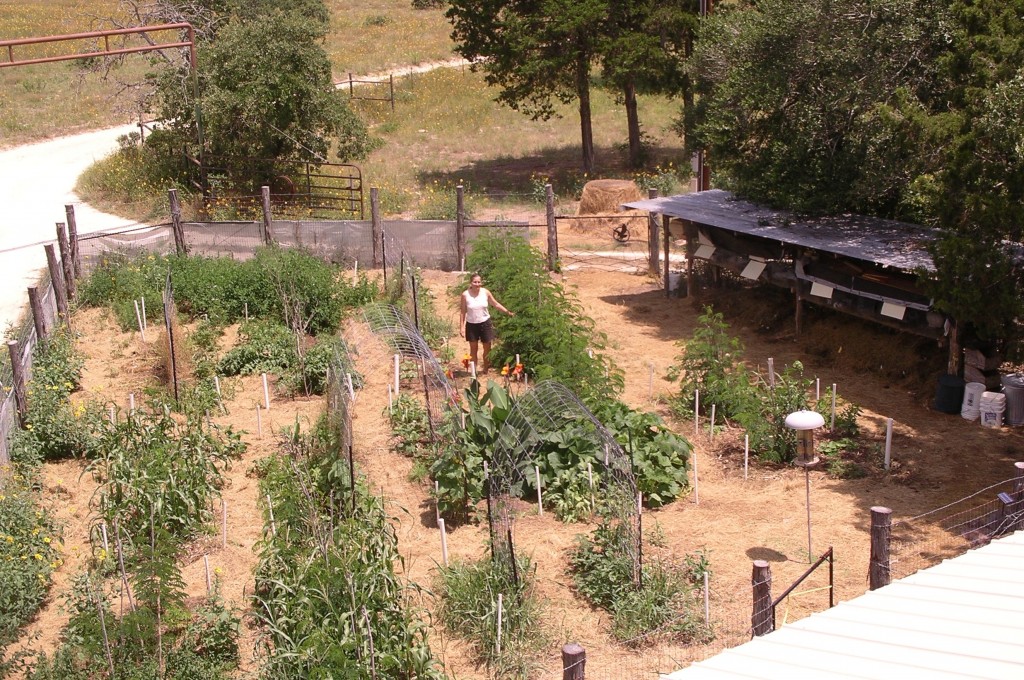
Marjory’s Texas garden
The home video, including Marjory, husband Dave and their young son and daughter, demonstrates (also with charts and a handy bonus reference CD) how the family planned and created their self-sufficient homestead. Marjory shows how they made soil from Texas sand and clay, set up rainwater catchment systems, began raising livestock and how more than half their diet comes from organic food they grow.
“Americans are incredibly under-nourished people,” Marjory said. “I believe it is why so many are so ill.”
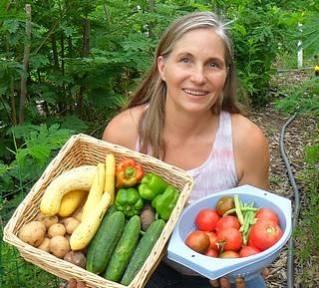
Marjory in her garden
Ninety-five percent of food in mainstream grocery stores is toxic, says Marjory, adding that the United States is no longer food-self-reliant as it imports 65 percent of its fuel needed to grow the major crops of corn, wheat and soy.
After watching the video, I just had to learn more about the gutsy, funny, down-to-earth woman who was not afraid to admit her early gardening blunders or show how to slaughter a rabbit with compassion and dignity. By the way, Marjory recommends fasting for 24 hours before butchering your first home-raised rabbit – not to combat nausea, but to appreciate why we cultivate animals for food.
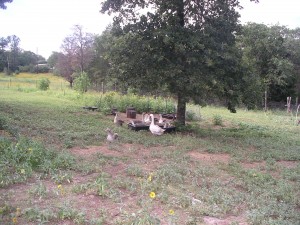
The geese provide food and fertilizer
Originally a city girl from Florida, Marjory didn’t grow up plucking geese, composting grass clippings, gathering wild herbs, harvesting turnips or eating bugs. None of that started until decades later when she says she “freaked out and panicked” over the fear of potential U.S. economic collapse.
In the 1990s when Marjory was an ex-pat electrical engineer working for Motorola in China, an Australian couple told her about the ideas of permaculture and self-reliance. Looking out from the 46th floor of her Hong Kong apartment, Marjory wondered, “Why would I ever need to know about that?”
The years passed and Marjory left Motorola to become an engineering consultant with clients all over Southeast Asia. She loved the travel, her work and enviable income. Fascinated by money, she later created a successful real estate investing firm where she managed tremendous amounts of debt for millionaire real-estate investors. Marjory did very well for her investors and immersed herself fully in everything related to money, the world economy, and markets.
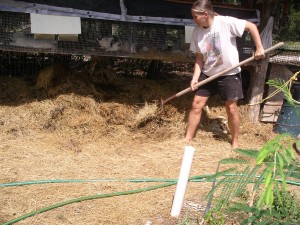
Marjory turns the compost pile under the rabbit hutches
Curious to where all the money she was managing was coming from, Marjory traced it back and began analyzing the business models of U.S. government-backed mortgage companies, Fannie Mae and Freddie Mac.
Her research alarmed her. She saw a vulnerable interconnection of the mortgage companies, banks, insurance giants, and brokers that were in dire financial and legal trouble. From her research, Marjory saw that global economic collapse was inevitable.
“I said, ‘Oh, dear. If they go under, we’ll all be in trouble.’ The dominoes would topple,” Marjory told me when I called her Texas home this week to ask about the inspiration behind her gardening videos.
Starting in 2001, Marjory spent the next year and a half dismantling her consulting business and urging her clients to get out of the real estate investment business before the bubble burst. Although skeptical at the time, they trusted her instincts and later thanked her.
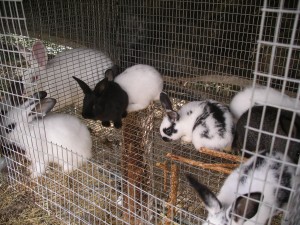
Rabbits are small, quiet and easy to care for
Meanwhile, Marjory continued traveling, this time to talk with people who had survived disaster, whether it was caused by national economic collapse, weather, war or other reasons. The number one thing they told her was that the ability to grow food was central to survival.
Dave and Marjory began searching for a homestead, a place where they could grow food year-round and work toward self-reliance. They settled in Dave’s home state of Texas, an hour’s drive from Austin. Then they began learning through a broad range of forestry, permaculture, rainwater collection and gardening classes as they set up their own systems.
“Grow Your Own Groceries” chronicles what they learned along the way. I was particularly interested in their rainwater systems, intended to be their main water source, until persistent drought forced them to drill a well. Still, if you’ve got it, rainwater is best for growing plants, followed by pond water and well water, Marjory says.
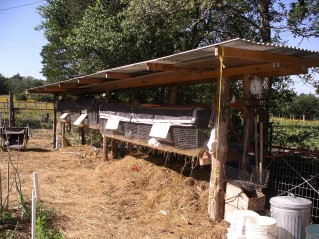
This 20′ rabbit hutch feeds the family of 4 year-round
“We started getting pretty good at growing things,” Marjory said, adding how they expanded into the whole gamut of skills needed for self-reliance; making and using herbal medicine, defense, treating water, making clothing with natural materials, bartering skills, food preservation, woodlot management, and so much more.
Marjory said that on their journey to self-sufficiency, they realized how important it is to share their skills and knowledge with their community. “I realized that community is absolutely vital to survival,” she said.
Not only can neighbors trade vegetables and skills, they can pool their resources to buy in bulk to save money. Also, if one is especially gifted at cultivating bees, another might grow the best potatoes or make wooden barrels. As Marjory sought ways to strengthen her local community, she found herself being a teacher, bringing people to the farm for hands-on lessons.
“The demand got so big, we couldn’t keep up. I physically couldn’t keep up,” Marjory said.
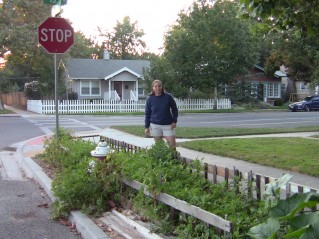
Marjory shows how a garden can be planted next to the street in Boise, Idaho
In 2009, Dave and Marjory produced their video with vivid details and practical instructions as a way to help more people feed themselves. “Grow Your Own Groceries” became a way to show people everywhere how to grow food anywhere, with special emphasis on backyard gardening and small livestock rearing. There are over 300,000 copies of the video being used all over the world – by homesteaders, survivalists, missionary organizations, and universities.
“Diversity is key,” Marjory said, explaining that perennial plants should be mixed with annuals, wild edibles, insects (an excellent source of Omega 3 fatty acids), livestock, and wild game. If one crop fails in a particular year, another may flourish. Realizing the need for urban and suburban solutions, Marjory is now experimenting with aquaponics.
“We have got to shift and change and evolve,” she said.
Marjory went on to explain how she loves the whole homesteading way of life. Her dream is for every family to enjoy the satisfaction and good health gained from eating food they grew themselves. The catalyzing statement for her organization is “Homegrown Food on Every Table.”
“In my journey, I’ve found that returning to a life where I produce most of my own basic needs has been the most fulfilling thing I’ve ever done,” Marjory said. “The inner strength that comes from eating deeply nutritious food that I’ve grown myself, the confidence from knowing I can provide for my family no matter what, and the joy of independence from tyrannical systems, are all so worth it.”
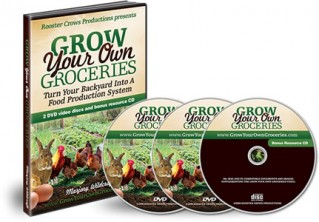
To learn more about Marjory Wildcraft and “Grow Your Own Groceries,” visit growyourowngroceries.org.
© 2013 Well WaterBoy Products LLC ♦ WaterBuck Pump™ ♦ Pedal Powered PTO™


If Marjorie is looking into aguaponics, I suggest she check out Friendly:
I don’t know enough to judge, but they look knowledgeable and they are open source.
Bobby